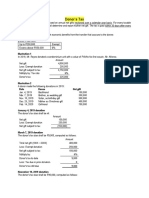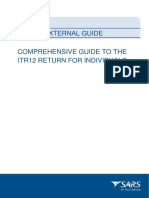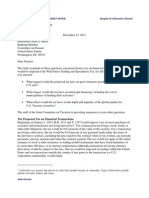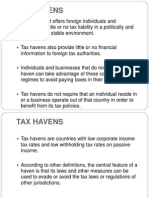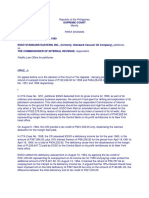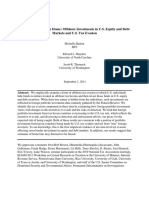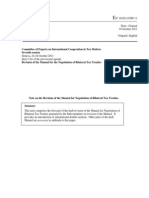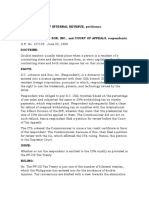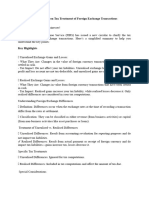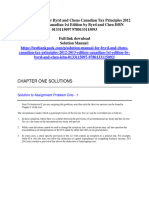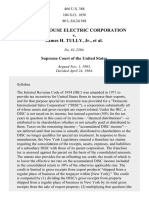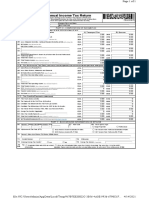And Summary: Northfield, MN 55057
And Summary: Northfield, MN 55057
Uploaded by
gags1984Copyright:
Available Formats
And Summary: Northfield, MN 55057
And Summary: Northfield, MN 55057
Uploaded by
gags1984Original Title
Copyright
Available Formats
Share this document
Did you find this document useful?
Is this content inappropriate?
Copyright:
Available Formats
And Summary: Northfield, MN 55057
And Summary: Northfield, MN 55057
Uploaded by
gags1984Copyright:
Available Formats
National Tax Journal, Vol. 42, no. 1, (March, 1989), pp.
59-68
TAX TREATMENT OF FOREIGN EXCHANGE GAINS AND LOSSES AND THE TAX REFORM ACT OF 1986** JENNY BOURNE WAHL* ABSTRACT This paper docunwnts the changes in the taxation of foreign exchange gains and losses brought about by the Tax Reform Act of 1986. The timing of recognition of foreign exchange gains and losses is important in determining the effective tax rate on foreign currency-denominated assets. If such gains and losses are anticipated and are taxed on realization rather than accrued, U.S. taxpayers have an incentive to invest in strong currencies and borrow in weak ones. Although the Act eliminates some asymmetries and clarifies the law, it does not accrue all anticipated gains and losses and therefore may affect international financial decisions. 1. Introduction and Summary HE expected return to an asset deT nominated in a foreign currency has two distinct components: the cash flow in foreign currency and the expected change in the foreign currency value relative to domestic currency. If the two are taxed differently, the effective tax rates on foreign-currency-denominated assets and domestic-currency-denominated assets will diverge and international investment could be affected. Section Il stresses that the timing of recognition of the second component is key in determining the effective tax rate on foreign assets. Gains and losses resulting from anticipated exchange rate changes are taxed at the same statutory rate as stated interest under current U.S. law. Accrual of anticipated gains and losses would therefore equalize effective and statutory rates on foreign assets, leaving international investment decisions of U.S. taxpayers unaltered by taxes. Taxation of expected Lrains and losses on realization would, however, cause the two rates to diverge. The effective rate on assets denom*St. Olaf College,
Northfield,
MN 55057.
inated in currencies expected to appreciate against the dollar would fall short of the statutory rate because gains would be deferred. Similarly, the effective rate on assets denominated in currencies expected to depreciate against the dollar would exceed the statutory rate because losses would be deferred. As a result, realization-based taxation would give U.S. taxpayers an incentive to invest in strong currencies and borrow in weak ones. Section III describes the U.S. tax treatment of exchange gains and losses, as modified by the Tax Reform Act of 1986.' The Act eliminates a number of asynimetries and clarifies the treatment of foreign assets and liabilities. Current law does not, however, tax all anticipated exchange gains and losses on accrual and may therefore affect international investment decisions. Currency gain or loss can arise from two sources: foreign-currency transactions and direct investment in foreign affiliates. U.S. tax treatment of gains and losses differs not only across sources, but also within each source. Transactions fall into three categories: (1) 988 hedging transactions, on which only anticipated gains and losses arise and are taxed on accrual, (2) 1256 contracts, on which all gains and losses are taxed on accrual and (3) all other transactions, on which ' all gains and losses are taxed on realization. Because most foreign-currency transactions conducted by U.S. taxpayers reportedly fall into the former two categories, Ti.S. taxation maY not substantially affect the currencies in which transactions are denominated. To the extent taxpayers can avoid accrualbased taxation by structuring ttansactions outside the rules for 988 hedging transactions and 1256 contracts, however, portfolio investment could be influenced. Direct investment may be affected by taxes as well. Exchange gains and losses on direct investment are taxed mainly on realization, even if affiliate in59
National Tax Journal, Vol. 42, no. 1, (March, 1989), pp. 59-68
60
NATIONAL
TAX JOURNAL
[Vol. XLII
vestments are hedged and gain or loss is fully anticipated. Moreover, branches and subsidiaries are treated asymmetrically. Gains and losses on branch investments are generally taxed solely on realization, while gains and losses on subsidiary investments may be taxed partly on accrual. Section IV concludes by suggesting that an empirical assessment of tax incentives would be useful. An appendix discusses complicating factors arising from the U.S. foreign tax credit system. 11. Anticipated and Unanticipated Exchange Gains and Losses, The Timing of Recognition, and Effective Tax Rates Expected inflation differentials between countries are directly associated with expected exchange rate changes.' Therefore, stated nominal interest determines the expected yield on most domes tic assets, while stated nominal interest and anticipated exchange gain or loss together determine the expected yield on foreign assets. Anticipated gain or loss on the principal of a foreign-currency loan, for example, equals its foreign-currency value multiplied by the difference between the spot exchange rate expected at the time of principal repayment and the spot exchange rate at the time the loan is made. Suppose a U.S. lender expects an exchange loss on a foreign-currency loan because foreign inflation is expected to exceed U.S. inflation. The loan will therefore carry a stated interest rate greater than the interest rate on a comparable dollar loan. If the lender expects a gain, the loan will carry a lower-than-dollar rate. Calculation of anticipated exchange gain or loss requires an estimate of the expected future spot rate One possible measure is the forward rate that corresponds to the term of the loan. If covered interest rate parity is assumed, the forward rate is a good proxy for hedged transactions. If uncovered interest rate parity and purchasing power parity are assumed, the forward rate could act as a proxy even for unhedged transactions.
Tax considerations potentially affect taxpayers' holdings of domestic- and foreign currency-denominated assets and liabilities. Suppose the same statutory tax rate is applied to interest and to currency gains and losses. The statutory rate equals the effective rate for domestic assets and liabilities. If anticipated gains and losses were accrued, statutory and effective tax rates would also be equal for foreign assets and liabilities. Taxes therefore would not influence investment. International investment would be affected, however, if anticipated gains and losses were not taxed until they were realized. Anticipated gain on the principal of a loan, for example, could be deferred until the loan was repaid. Realization-based taxation would cause the effective tax rate to fall short of the statutory rate on assets denominated in currencies expected to appreciate against the dollar. Investors thus would have a tax incentive to hold appreciatingcurrency assets. By the same token, realization-based taxation would cause the effective rate to exceed the statutory rate on assets expected to depreciate against the dollar. As a result, borrowers would have a tax incentive to borrow depreciating currencies.' Levi's (1977) model generates similar tax incentives, but for another reason. His paper assumes that different statutory tax rates on interest and on currency gains and losses produce different effective tax rates on domestic and foreign assets. This paper assumes uniform statutory rates but different effective rates if currency gains and losses are deferred. Statutory rate differences and deferral were both important considerations before the Tax Reform Act of 1986. Before the Act, the capital gains tax rate was generally less than the ordinary income tax rate, and currency gains and losses were often characterized as capital while interest was characterized as ordinary. Gains and losses were also taxed mostly on realization. Because the Act equalized the two statutory rates, only deferral remains an issue under present U.S. law.' Total exchange gain or loss may include unanticipated as well as anticipated gains and losses, unless a taxpayer
National Tax Journal, Vol. 42, no. 1, (March, 1989), pp. 59-68
No. 11
FOREIGN
EXCHANGE
GAINS AND LOSSES
61
is fully hedged. The timing of recognition of unanticipated gains and losses is gen erally irrelevant for prospective intei*national investment.5 However, the timing and amount of tax revenues may differ under realization-based and accrual-based taxation of unanticipated gains and losses, because realization-based taxation gives taxpayers more discretion. For instance, taxpayer with an unanticipated loss on foreign-currency-denominated asset could sell the asset, reduce taxes on other income, and purchase a similar set of as.6 sets to replace the sold asset Stiglitz (1981) makes the same point in his analysis of the taxation of capital gains. III. U.S. Tax Treatinent Gains and Losses A. Transactions. Before the Tax Reform Act of 1986, the courts allowed taxpayers favorable treatment of exchange gains and losses on several types of transactions, with loss recognition on accrual but deferral of gain recognition until realization.' The Act eliminates this asymmetric treatment by instituting accrual of exchange gains and losses for the majority of transactions. For some transactions, however, the asymmetry is remedied by permitting deferral of both gains and losses. The tax law distinguishes three types of foreign-currency transactions: 988 hedging transactions, 1256 contracts, and all other transactions. By definition, ex change gains and losses on 988 hedging transactions are fully anticipated. Under IRS Notice 87-11 (1987), these gains and losses are taxed on accrual. The accrual procedure resembles an original issue discount calculation, which determines the yield on a dollar-denominated debt instrument sold at a below-par price. Part of the yield on an original issue discount obligation is the implicit gain on the prin cipal. The original issue discount rules under 1271 1275 tax this gain as it ac crues. 8 All exchange gains or losses on a foreign-currency contract such as a forward, of Exchange
a future, or an option are taxed on a@crual if the contract is denominated in yen, pounds sterling, Deutsche marks, guilders, Swiss francs, French francs, Canadian dollars, or the ECU. This rule was enacted under 1256 in 1981. Anticipated exchange gains and losses on 1256 contracts, like those on 988 hedging transactions, are taxed as they accrue. If 1256 contracts are not hedged, unanticipated gains and losses are also taxed on accrual.' Exchange gains and losses from transactions other than 988 hedging transactions and 1256 contracts are not taxed until they are realized. The President's Tax Proposals (1985) advocated accrual of anticipated gains and losses for all transactions, but Congress rejected the proposal for primarily administrative reasons. Although anticipated gains and losses from short-term unhedged transactions might be determined by using forward exchange rates as proxies for expected future spot rates, forward rates or other proxies may not be readily available for the long term. As the previous section showed, this realization-based taxation of exchange gains and losses creates potential tax incentives. Distortions from non-accrual may be small for at least three reasons. First, businesses usually hedge their foreigncurrency-denominated portfolio assets and liabilities, particularly long-term ones. Gains and losses accrue on these transactions under Notice 87-11 or under 1256. Second, many unhedged transactions are likely to be 1256 contracts, on which all gains and losses are accrued. Third, gains and losses on unhedged transactions that are not 1256 contracts are likely to be unanticipated; predicted changes in exchange rates generally account for a small proportion of actual changes-10 Taxpayers are thus unlikely to benefit systematically from deferring gains and losses on unhedged transactions." The distortions caused by non-accrual, on the other hand, could be substantial. Although Notice 87-11 allows the Internal Revenue Service to identify hedges, multinationals may conceal them by hedging through one or more affiliates,
National Tax Journal, Vol. 42, no. 1, (March, 1989), pp. 59-68
62
NATIONAL
TAX JOURNAL
[Vol. XLII
closing hedged transactions on different days, combining several complicated transactions to form a hedge, or otherwise instigating transactions that are not addressed by the Notice or by 1256." The importance of tax incentives on portfolio holdings caused by non-accrual remains uncertain. B. Direct Investment in Affiliates U.S. taxpayers invest overseas directly through branches and subsidiaries. The two are taxed differently under U.S. lawbranch earnings are taxed annually, but subsidiary earnings are taxed only when dividends are remitted to the U.S. parent." Branch taxation therefore is analogous to the taxation of transactions. For subsidiaries, deferral creates incentives for tax-minimizing strategies for international sourcing of funds and for repatriation. " Before the Tax Reform Act of 1986, taxpayers could choose from a variety of methods for calculating foreign affiliate income. The Act provides that income from a given type of affiliate must be calculated using a single method, but it does not consistently adopt accrual-based taxation of exchange gains and losses. Gains and losses on branch investments are generally taxed on realization, but those on subsidiary investments may be taxed partly on accrual. As a result, two potential problems arise. First, if parents hedge foreign affiliate investments, realizationbased taxation may influence direct investment. The Supreme Court has recently established that these economic hedges effectively cannot be treated as hedges for purposes of the currency gain and loss rules." Second, the asymmetry in recognition rules for branches and subsidiaries could affect the choice of an affiliate's organizational form. 1. Branches. Before the Tax Reform Act, branches could use either a net-worth or a profit-loss method of income recognition. Under the former, the value of each asset and liability was translated into dollars at the end of the year. The increment in the branch's dollar net worth over the previous year's dollar net worth was
taxed. Under the latter, only the value of annual profit was translated into dollars. Translated profit was taxed, and recognition of exchange gain or loss was deferred until branch investments were repatriated to the parent. The Act generally establishes the profitloss method for branches." As with transactions, non-accrual might result in different effective tax rates on branch investments denominated in various foreign currencies. If branch investments are hedged, deferral could create tax incentives to invest in appreciating-currency countries relative to depreciating-currency countries." On the other hand, if branch investments are not hedged, the profit-loss method avoids the uncertainty in tax payments associated with the networth method. The net-worth method accrues all gains and losses, not just anticipated ones." Given the variance of exchange rates, a U.S. parent would face much more variability in tax payments on foreign branch investments than on dollar-denominated assets under the networth method. For budgetary reasons, the parent might therefore choose to invest less abroad than it would under the profitloss method. As with transactions, a method that would tax accrued anticipated exchange gains and losses on branch investments would not generate diverse effective tax rates. However, it could be difficult to gauge anticipations for long-term investments because long-term forward rates or other proxies for expected future spot rates are generally unavailable. If branch investments are not generally hedged and long-run expectations are hard to measure, the profit-loss method may be more easily administered than a method that accrues anticipated gains and losses. It may also be simpler to use than the networth method. As with transactions, the significance of tax incentives caused by non-accrual has yet to be estimated. 2. Subsidiaries. In contrast to branch income, income from foreign subsidiaries is taxed in the U.S. only when dividends are repatriated. Net repatriated dividends are grossed up by foreign taxes to obtain a gross income inclusion for the U.S.
National Tax Journal, Vol. 42, no. 1, (March, 1989), pp. 59-68
No. 11
FOREIGN EXCHANGE GAINS AND LOSSES
63
parent, which is the basis for pre-foreigntax-credit U.S. tax liability. The U.S. parent is entitled to a credit on its total tax bill for foreign income taxes paid by the subsidiary. The credit is based on the percentage of total profits repatriated and the parent's percentage of ownership. Both net dividends and foreign taxes must be translated into dollars before calculating the gross incozne received from the foreign subsidiary and the foreign tax credit. The foreign currency actually received by the U.S. parent is the net dividend amount and is logically translated at the exchange rate in effect on the repatriation date. However, the appropriate exchange rate used to translate foreign taxes has been a subject of considerable controversy. Some argue that the exchange rate in effect at the time of the dividend distribution should be used. Others maintain that the exchange rate in effect at the time taxes were paid is more appropriate." In fact, the exchange rate chosen bears directly on the timing of recognition of anticipated exchange gains and losses on unrepatriated subsidiary investments. Before the Tax Reform Act, taxpayers could use either current or historical exchange rates to translate foreign taxes into dollars.2' The two methods are comparable, though not identical, to the profit-loss and net-worth methods for branches. To see the parallel, suppose foreign and U.S. statutory tax rates are equal, foreign currency is expected to appreciate against the dollar, and expectations are borne out so yields fully reflect actual exchange gains. 21 Suppose foreign subsidiaries repatriate earnings every other year. Under current-rate translation of foreign taxes, a U.S. parent would pay no residual U.S. tax on foreign dividends as they were repatriated. Therefore, gains on unrepatriated contributed capital would remain untaxed. Similarly, no U.S. ta K would be assessedon branch earnings under the profitloss method, because no gains would be accrued and foreign taxes would fully offset U.S. tax liability. In contrast, a U.S. parent would pay residual tax under historical-rate translation for subsidiaries and under the net-worth method for branches.
Because the foreign currency would have appreciated, historical-rate translation would result in a lower gross-up for foreign taxes than current-rate translation, yielding an effective foreign tax rate lower than the statutory rate. As a result, some U.S. tax would be assessed on foreign subsidiary earnings as dividends were repatriated. Similarly, the net-worth method would produce residual tax liability on branch earnings because accrued gains would auginent the tax base without increasing foreign taxes. The Tax Reform Act requires historical-rate translation of foreign taxes. Although this method resembles the networth method, unlike the net-worth method it does not result in full accrual of exchange gains and losses. No method of translating foreign taxes could yield Ul accrual unless foreign subsidiary earnings were annually repatriated. Ironically, historical-rate translation accrues anticipated gains and losses on unrepatriated investments only if earnings are not annually distributed. Under annual distribution of earnings, historical-rate translation is no different than currentrate translation. Historical-rate translation may therefore affect international direct investment. It may permit taxpayers to generate artificial gains and losses on subsidiary investments. For instance, suppose the exchange rate is not expected to change, but in fact oscillates in the period before repatriation and returns to the original rate in the year of repatriation. An artificial loss generated by previous exchange rate movements would allow taxpayers to reduce tax liability on other foreig'n-source income if dividends were repatriated. Historical-rate translation of foreign taxes can therefore Create marginal tax incentives for repatriation where no economic incentive exists. Furthermore, the asymmetric treatment of branches and subsidiaries may skew a U.S. parent company's choice of organizational form for its foreign affiliates, particularly if the parent can hedge its investments. Historical-rate translation for Subsidiaries is more like accrual-based taxation, while the profit-loss method used for
National Tax Journal, Vol. 42, no. 1, (March, 1989), pp. 59-68
64
NATIONAL
TAX JOURNAL
[Vol. XLII
branches is strictly realization-based. As with portfolio investments and branch investments, accrual-based taxation of anticipated exchange gains and losses on foreign subsidiary investments would minimize variations in effective tax rates. However, as in the branch case, measuring anticipations could be diffi cult. In addition, deferi-al of recognition on subsidiary earnings until repatriation makes accrual-based taxation impossible. As a result, the significance of tax incentives engendered by historical-rate translation of foreign taxes remains an open question. It depends on the extent of hedging, the importance of taxes in choosing an organizational form, and the influence of taxes on dividend repatria tion. IV. Conclusion. This paper explains why the timing of recognition of foreign exchange gains and losses directly influences the effective tax rate on foreign assets and liabilities. Accrual of gains and losses anticipated through interest rate differentials would preserve the statutory tax rate as the effective rate. Taxation of gains and losses as they are realized, however, would cause the effective rate to deviate from the statutory rate and potentially create marginal tax incentives in international investment. The Tax Reform Act of 1986 adopted accrual-based taxation for anticipated exchange gains and losses on many transactions through hedging rules described in IRS Notice 87-11. All gains and losses on the majority of remaining transactions are taxed on an accrual basis under 1256, which existed before the Act. However, all gains and losses on transactions not covered by Notice 87-11 or 1256 are taxed on realization. Gains and losses on foreign branch investments are also taxed on realization. Congress chose realization-based taxation primarily for administrative reasons. Unanticipated exchange rate movements far outweigh anticipated movements, only anticipated gains and losses are important for in-
vestment decisions, and the calculation of anticipated exchange gains and losses may be difficult, particularly for long-term investments and liabilities. To the extent taxpayers hedge but can avoid accrual based taxation, though, there may be tax incentives for investing in portfolio and branch assets denominated in currencies appreciating against the dollar and for incurring liabilities denominated in currencies depreciating against the dollar. In contrast to branch taxation, anticipated exchange gains and losses on investments in foreign subsidiaries are taxed partly on accrual. Foreign subsidiary income is taxed only when dividends are repatriated, and a credit is granted for the foreign taxes paid by the subsidiary. Taxes must be translated into dollars to calculate the foreign tax credit. Partial accrual is implemented by translating at the exchange rate in effect the date taxes were paid to the foreign government. Historical-rate translation may seem appropriate because some anticipated exchange gains and losses may be accrued. However, it has the drawback of potentially allowing taxpayers to generate artificial gains and losses. Moreover, the difference in treatment of exchange gains and losses arising from branches and subsidiaries may affect a U.S. parent's choice of organizational form for its foreign affili ates. The Tax Reform Act improved tax law by clarifying the tax treatment of currency gains and losses arising in various contexts, by eliminating the asymmetry of loss recognition on accrual but gain recognition on realization, by barring taxpayers from a choice of income translation method for foreign affiliates, and by implementing accrual-based taxation of hedging transactions. However, it is not obvious whether the administrative ben efits of the realization-based taxation permitted for some transactions and for branches exceed the costs of potential tax incentives for international investment. Nor have the costs of possible incentives caused by the adoption of historical-rate translation of foreign taxes for subsidiaries been quantified.
National Tax Journal, Vol. 42, no. 1, (March, 1989), pp. 59-68
No. il
FOREIGN
EXCHANGE
GAINS AND LOSSES
65
Growth,andSimplicity(1985), anticipatedf@ulg andKaYOil and As a result, several issues invite ern- ness, of pirical investigation. The Significance of (1985) pro@ideadditional discussion unaiiticipated gains and losses. spayer fmin tax incentives induced by the tax treatWqsh salc, rules 11391 ta under barhe t purmentofforeign exchange gainsandlosses lowering taxes when a single similar asset I-' ' could be better gauged if the following chased as a replacement. tj S court 'Both precedents were established in the could be estimated: the value of hedged of Appeals for the Sixth Circuit The court allowed transactions escaping the hedging rules, urrent recognitionof lossesin National-Staftdard' the degree of hedging of foreign affiliate supra However,in KettULk & Indiana 7,errniaal v 1969), RailroadCo. v U.S 330F 2d 520(6th Cir,,rgeof investments, and the extent to which tax ' gains er, ruled to be inec-i from the d@slh 11 iie factors affect dividend repatriation and the income indebtedness. Under 9108 and 1017, such choice of organizational form. not recognized currently. U, dis'Garlock (1987) discusses the original Iss count rules in detail. 'The majority of 1256 contracts are reported to be that ENDNOTES hedged The wording of 988 makes it 256rather clear , hedged @ contracts are taxed under 1256 **The author gratefully acknowledges the help of than under Notice 87-11. For purpose,,, fthis F)ap O acDaniel Frisch, Edward Wahl, and an anonymous ref the difference in treatment of 988 hedging t"'s eree tions and hedged 1256 contracts is Immater,31@this 'The Tax Reform Act is Public Law 99-514. The In 'omussa (1979) and Prenkel (1981,1982)discuss ternal Re@enueCode. which is contained in Title 26 point. of the US Code, addresses foreign exchange gains and "Hyperinflationary currencies are a different case. rren, losses in @@@985-989 Losses on transactions in hyperinflationary cu, po2 Caves (1975) and Cuniby and Obstfeld (1984 show ciesare largely anticipated, andnon-accrualCo" spethis in their models tentially twist investment decisions.Howeier, fourth a 'This paper uses a partial equilibrium analysis and cial rule in the Tax &form Act provides 3 e does not address the interaction of savings and in reason distortionary effects may be inininlzed. loans denomivestment, Feldstein (1976) uses a closed-economy rule taxes accrued losses annually on are general equilibrium model and Hartman (1979) and nated in a hyperinfjationary currency if the loans ' Gordon (1986) use open-econorny general equilibrium made to shelter other foreign-source incorno, sheet models. "Offsetting balance-sheet items' or "bqlance- Ons 'Before the Tax Reform Act, currency gains and hedges," are prevalent among financial losses were characterized as ordinary income or loss and have not yet been regulated, Nor have ,,Off,bal narilY if the foreign currency was used as a part of the taxance-sheet" items, because they are not curlto y be payer's trade or business under Corn Products Refin reported. However, reporting requirertients f@lI Acing Co. v. Commissioner, 350 U.S. 46 (1958) Other changing A recent draft issuedby the Financ"q. DISCI wise, the Internal Revenue Service held that gains counting Standards Board (ExposureDraft' sed were capital (Rev. Rul. 78-396, 1978-2C,B. 114;Rev. sures about Financial Instruments, 1987) PROPO Rul 78 281, 1978 2 C.B. 204; C C.M. 39294,June 15, disclosure for off balance-sheet transactions. 1984), and the courts held that losses were ordinary "'I'hi:3 is true only for dividends from active "come pas under National Standard Co. v. Commissioner, 80 T.C. under @4901905 U.S. shareholders are taxed ()11the 551 (1983), afrd 749 F.2nd 369 (6th Cir. 1984) Be- sive income under 951 964 as it is earned by cause the Act removed the disparity in statutorv rates, subsidiary. the question of character is relatively minor. For those "Although Hartman (19E@5) shows that deferral for important is interested, O'Neill and Lee (1986) exhaustively re irrelevant for existing investment, it is V.S. view characterization for different types of transac- new investment if foreign tax rates differ fton' liations. The one instance in which the capital-ordinary tax rates. Because a U.S parent defers U.S ta)rtive distinction is important under present law is when bility, it will have an incentive to invest pro,pec tes both currency and capital gains or lossesare incurred dollars in subsidiaries in countries with lower to ra on a transaction, because capital losseb are allowed than the U S., as Newlon (1986) shows.Frls(!,, (1983) only against capital gains for corporations. (Individalso discusses deferral issues, f Internal uals may take up to $3000 of net capital loss against '5Arkansas Best Corp. v. Co?nmissioner0 ordinary income ) The Act constrains the amount of Revenue (U.S. Sup. Ct., No. 813-751,March 7, 1988) stoek currency gain or loss to be no larger in absolute value established that gain or loss on foreignsubsidio'Y Corn than the total gain or loss realized on the transaction. cannot be characterized as income under the t apTherefore, if a taxpayet- has a currency gain that is Products doctrine @supra), o Notice 87-11caillo s perfectly offset by a capital loss on a transaction, the ply. constraint would net the two No tax would be as'6The tax code under 989 ;allows for regul3t',Ovt)o'slit'do sessed, accurately reflecting the taxpayer's unprescribe an income calculation method that changed economic position. qepapproximate the translation in to dollars of @,ch could 'The Treasury Department Discussion Draft on arate transaction. As a result, future regulatio "s Taxing Foreign Exchange Gains and Losses (1980), The permit a net-worth type method under certain eir President's Tax Proposals to the Congress for Fair cumstances.
National Tax Journal, Vol. 42, no. 1, (March, 1989), pp. 59-68
66
NATIONAL TAX JOURNAL
[Vol. XLII
"I have assumed that an inve,t.Lrit in a given "Exchange gains and losses arising through forcountry is denominated in the currency of that coun- eign affiliates are foreign-source. try. Under present U S. law, each business unit of a U.S taxpayer is required to keep its records in terms BIBLIOGRAPHY of its functional currency, or the currency in which it conducts the bulk of its business. The concept of fune tiorial currency was introduced in the Statement of Caves, R. 1975. "Looking at Inflation in an Open Financial Accounting Standards No 52: Foreign Cur Economy." In Inflation, Trade, and Taxes Essavs rency Translation (1980) and was borrowed by the in Honor of Alice Bourneuf. Columbus, OH Ohio Treasury Department Discussion Draft on Taxing State University Press. Foreign Exchange Gains and Losses (19801 ThereCumby, R. and Obstfeld, M. 1984. "International In. fore, a French branch may be required to keep records terest Rate and Price Level Linkages." In Exchange in terms of yen instead of francs if most of its trans Rate Theory and Practice. Edited by J. Bilson and actions are with Japan. This does not change the thrust R. Marston. Chicago, IL: The University of Chicago f the analysis. Press "The net worth method as applied before the Tax Feldstein, M. 1976. "Inflation, Income Taxes and the Reform Act did not perfectly accrue exchange gains Rate of Interest: A Theoretical Analysis." Ameri and losses Long-term assets and liabilities were can Economic Review 66 (December):809 20. translated into dollars at historical exchange rates, in Financial Accounting Standards Board. 1980. Stateaccordance with generally accepted accounting prinment of Financial Accounting Standards No. 52 ciples. Therefore, if a foreign branch in a depreciatForeign Currency Translation. Stamford, CN: Fiing-currency country had short term assets exceeding nancial Accounting Standards Board short-term liabilities and long-tem liabilities exceed- 1987 Exposure Draft: Disclosures about Finaning long-term assets, the calculated change in dollar cial Instruments. Stamford, CN: Financial Account net worth would have been greater in absolute value ing Standards Board. than the actual change. If the opposite were true, the Frenkel, J. 1981. "Flexible Exchange Rates, Prices, calculated change would have been less in absolute and the Role of 'News': Lessons from the 1970s." value than the actual change. Journal of Political Economy 89 (August):665 705. 11'rhe controversy is documented in Treasury De-. 1982. "United States Inflation and the Dollar " partment Discussion Draft 1980, The President's Tax In Inflation. Edited by R. Hall. Chicago, IL: The Proposals (1985), and The Tax Reform Act of 1986 University of Chicago Press. (House Report 99 841, 1986) Frisch, D 1983. "Issues in the Taxation of Foreign "Current-rate translation was prescribed in Bon Source Income." In Behavioral Simulation Methods Ami Co u. Commissioner, 39 B.T.A. 825 (1939), and in Tax PolteyAnalysts. Edited by M. Feldstein. Chihistorical rate translation in H. H. Robertson & Co., cago, IL: University of Chicago Press. 59 T.C. 53 (1972) and American Metal Co, 21 F.2d. -. 1987. "The U.S.'s International Investment Pat 134, 141 (2d. Cir 1956) terns and Taxation." In Proceedings of the Eigh "The foreign tax rate was implicitly assumed to be tieth Annual Conference on Taxation. Columbus, OH: National Tax Association Tax Institute of America. zero in the section on branch taxation. 2'These rules are contained in 901 905. Frisch Garlock, D. 1987. A Practical Guide to the Original (1983) also discussesforeign tax credit issues. Issue Discount Regulations. Clifton, NJ: Prentice IMB analysis assumes that existing interest source Hall Law and Business rules are appropriate. Gordon, P 1986 "Taxation of Investment and Sav2The principle underlying allocation of interest ex ings in a World Economy." American Economw Re pense is fungibility of funds. A U.S corporation flview 76 No. 5 (December): 1086 1102 nancmg the building of a plant abroad can bon -ow from Hartman, D. 1979. "Taxation and the Effects of InU.S. or foreign banks. Moreover, bank funds used to flation on the Real Capital of an Open Economy." finance the foreign plant could have been borrowed Internatwnal Economic Review 20 No. 2 (June):417 so that the corporation could internally fund the 25. building of a domestic plant Therefore, the attnbuHartman, D 1985 "Tax Policy and Foreign Direct tion of interest expense to foreign or domestic sources Investment " Journal of Public Economics 26 No is not based on location of borrowing. 1:107 21. 25Theinterest sourcing rules are appropriate only Kay, J., and King, J. 1985. Taxing Currency Fluctua for anticipated gain or loss. Under uncovered interest twn: The Tax Treatnwnt of Foreign Exchange Gains rate parity and purchasing power parity, unanticiand Losses. IFS Report Series No. 18. London, UK: pated exchange gains and losses would average out Institute for Fiscal Studies. over time. Therefore, unanticipated gains and losses Levi, M. 1977. "Taxation and 'Abnormal' Internacould appropriately be sourced as all foreign or all do tional Capital Flows." Journal of Political Economy roestic, provided that they were treated symmetri 85 (June):635 46. cally. There may be a slight argument for domestic Mussa, M. 1979. "Empirical Regularities in the Besourcing because carryover rules for net operating havior of Exchange Rates and Theories of the For losses are more generous than those for foreign tax eil-n Exchange Market." In Policies for Employ credits. ment, Prices, and Exchange Rates. Edited by K. "'These rules evolved from a somewhat strained Brunner and A. Meltzer. Carnegie-Rochester Coninterpretation of rules on property disposition under ference Series on Public Policy Vol 11 (supplemen 1.861-7 and 1.8618(e)(7), Code of Federal Regulatary series to the Journal of Monetary Economics, tions, Title 26 of the US. Code 1979).
National Tax Journal, Vol. 42, no. 1, (March, 1989), pp. 59-68
No. 11
FOREIGN
EXCHANGE
GAINS
AND LOSSES
67
Newlon, S. 1986. "Problems in the Empirical Study of the Effects of Tax Policy on International Direct Investment." Princeton, NJ (Manuscript). O'Neill, T. and Lee, C. 1986. "Federal Income Tax Treatment of Foreign Currency Transactions after the Tax Reform Act of 1986." Tax Notes (October 13):185 196. Stiglitz, J. 1981. "Some Aspects of the Taxation of Capital Gains." Washington, DC: Office of Tax Analysis (Manuscript). U.S. House of Representatives. 1986. Tax Reform Act of 1986. House Report 99-841. Washington, DC: U.S. Government Printing Office. U.S. Treasury Department. 1980. Treasury Department Discusswn Draft on Taxing Foreign Exchange Gains and Losses. Washington, DC: Office of Tax Analysis. U.S. Treasury Department 1985. The President's Tax Proposals to the Congress for Fairness, Growth, and Simplicity. Washington, DC: U.S. Government Printing Office. U.S. Treasury Department. 1987. Notice 87-11 (January). Washington, DC: Internal Revenue Service. Wahl, J. 1987. "Taxation of Foreign Exchange Gains and Losses." OTA Papers No. 57. Washington, DC: Office of Tax Analysis.
APPENDIX-SOURCING
ISSUES
In addition to timing of recognition, the source of foreign exchange gains and losses can affect taxpayers' incentives. The U.S. taxes the worldwide income of U.S. taxpayers but permits a credit for foreign income taxes imposed on foreign-source taxable income. The amount of taxable income by source is computed by first determining the sources of gross income, then allocating expenses to domestic- and foreignsource income. Taxpayers are generally granted a foreign tax credit only up to the point where the average foreign tax rate on foreign-source income equals the U.S. tax rate." This limitation ensures that the foreign tax credit offsets U.S. tax on foreign-source income only. If the average effective foreign tax rate were higher than the U.S. effective rate and the U.S. had no limitation, taxpayers could reduce U.S. tax on U.S.-source income. The paper implicitly assumes that the effective foreign tax rate is not greater than the effective U.S. rate. That is, taxpayers are assumed to have either a "shortage" of foreign tax credits or an exact offset to U.S. tax liability on foreign source income. U.S. taxpayers could also have an "excess" of foreign tax credits if the average effective foreign tax rate ex ceeded the effective U.S. tax rate. Because the Tax Reform Act of 1986 drastically reduced the statutory U.S. tax rate, many U.S. taxpayers are now likely to have excess credits. Frisch (1987) shows this empirically. The sourcing of income and expenses, in-
cluding exchange gains and losses, is impor tant for taxpayers with excess credits. Given worldwide income and foreign taxes, a taxpayer could increase its foreign tax credit limitation if it could transform domestic source income into foreign-source income. Therefore, it could reduce net U.S. tax liability. The same result follows if the taxpayer could transform foreign-allocated expense into domestically allocated expense. Because anticipated exchange gain or loss is one component of a taxpayer's yield from a foreign-currency-denominated asset, its appropriate source is based on the rules for interest." Interest income received directly from foreign ers is generally foreign-source; interest ex pense is allocated ratably to foreign and domestic sources on an asset basis.' If anticipated gains and losses were sourced differently than interest, taxpayers could favor certain curren cies for transactions and investments .2' For in stance,.if a taxpayer lent a depreciating currency, it would expect an exchange loss and would charge a higher interest rate than on a dollar loan. The loss would appropriately be netted against stated interest to derive the total foreign-source income figure used in the foreign tax credit limitation. The taxpayer would then have no tax incentive to lend depreciating currencies rather than dollars. If instead the anticipated loss were sourced domestically and the U.S. taxpayer had excess credits, it might have such an incentive. The inflated interest income would be foreign-source and the anticipated loss would be an expense allocated to domestic sources. Therefore, the foreign tax credit limitation would be artifically high and more foreign taxes would be credited than if the anticipated loss were netted against interest income. Neither prior nor present law adopts interest-based sourcing rules for anticipated currency gains and losses. Before the Tax Reform Act, taxpayers could have arranged all gains from transactions to be foreign-source by passing title to the foreign currency abroad. All losses could have been allocated on the basis of the income, domestic or foreign, generated by the foreign currency." Because income generated by foreign-currency transactions is generally foreign-source, both gains and losses were likely to have been foreign-source. In contrast, the Tax Reform Act sources all exchange gains and losses from transactions domestically." Wahl (1987) illustrates a number of cases in which the sourcing rules for exchange gains and losses could create international investment incentives. The importance of the incentives depends upon the ability of the taxpayer to predict exchange rate changes and is, as in other
National Tax Journal, Vol. 42, no. 1, (March, 1989), pp. 59-68
68
NATIONAL
TAX JOURNAL
[Vol. XLII
areas,primarily an empirical issue. As with the definition fully anticipated and are sourced actiming rules, the incentives are mitigated un- cording to the interest sourcing rules. Interest der U.S. law by special treatment for cases in income from hyperinflationary currency loans which the taxpayer can predict well, such as is domestically sourced to the extent of the loss hedging transactions and loans denominated on the loan, which is effectively the same as in hyper inflationary currencies. Exchange gains interest-based sourcing if all losses are anticand losses from hedging transactions are by ipated.
You might also like
- Principles of Maltese Income Tax Law 2019Document676 pagesPrinciples of Maltese Income Tax Law 2019sNo ratings yet
- Chapter 14 Multinational Tax Management Multiple Choice and True/False Questions 14.1 Tax PrinciplesDocument15 pagesChapter 14 Multinational Tax Management Multiple Choice and True/False Questions 14.1 Tax Principlesqueen hassaneenNo ratings yet
- Chapter 17 Donor's TaxDocument7 pagesChapter 17 Donor's TaxHazel Jane Esclamada100% (3)
- SARS Comprehensive Guide To The ITR12 Return For IndividualsDocument102 pagesSARS Comprehensive Guide To The ITR12 Return For IndividualsNick BesterNo ratings yet
- Income Taxation Banggawan 2019 Ed Solution ManualDocument40 pagesIncome Taxation Banggawan 2019 Ed Solution Manualqwerty 130% (1)
- International TaxationDocument45 pagesInternational TaxationDavid Ioana100% (1)
- Bankman 1989Document36 pagesBankman 1989Joffily OrbanNo ratings yet
- CBO Hatch Letter On Financial Transaction TaxDocument6 pagesCBO Hatch Letter On Financial Transaction TaxMilton RechtNo ratings yet
- Business Taxation Case StudyDocument5 pagesBusiness Taxation Case StudyVedant NairNo ratings yet
- Non Doctorinal Research Land Law - Stamp DutyDocument20 pagesNon Doctorinal Research Land Law - Stamp Dutykomalvjain21No ratings yet
- Deloitte FOREX TOFA November 2013Document4 pagesDeloitte FOREX TOFA November 2013don5450No ratings yet
- Foreign Investments in US REDocument25 pagesForeign Investments in US RETony ZhengNo ratings yet
- The Interpretation and Meaning of "Beneficial Owner" in New ZealandDocument31 pagesThe Interpretation and Meaning of "Beneficial Owner" in New Zealandryu255No ratings yet
- Tax Policy and Corporate Borrowing: Alan J. AuerbachDocument37 pagesTax Policy and Corporate Borrowing: Alan J. AuerbachAlexandra TuchilusNo ratings yet
- Tax Law and PracticeDocument8 pagesTax Law and PracticeAnorld MunapoNo ratings yet
- CFC, FSC and Tax HavensDocument14 pagesCFC, FSC and Tax Havensdigvijay bansalNo ratings yet
- International Tax TreatiesDocument6 pagesInternational Tax TreatiesNaila KhanNo ratings yet
- Foreign Exchange Taxation RulesDocument15 pagesForeign Exchange Taxation RulesAnil BanjaraNo ratings yet
- Real Estate Rental Income As Business' Income For State Tax PurposesDocument20 pagesReal Estate Rental Income As Business' Income For State Tax PurposesfalkynNo ratings yet
- Form 8960 InstructionsDocument20 pagesForm 8960 InstructionsforbesadminNo ratings yet
- ESSO Standard Eastern Inc Vs CIRDocument6 pagesESSO Standard Eastern Inc Vs CIRToya MochizukieNo ratings yet
- Taking The Long Way Home: Offshore Investments in U.S. Equity and Debt Markets and U.S. Tax EvasionDocument63 pagesTaking The Long Way Home: Offshore Investments in U.S. Equity and Debt Markets and U.S. Tax EvasionClinton BrowningNo ratings yet
- Federal International TaxationDocument20 pagesFederal International TaxationDANIEL MARTIN ARANA YANCESNo ratings yet
- The Stop Tax Haven Abuse Act SummaryDocument11 pagesThe Stop Tax Haven Abuse Act SummaryCitizens for Tax Justice100% (1)
- Aa TaxDocument22 pagesAa Taxnirshan rajNo ratings yet
- CRP11 Introduction 2011.PDF Double TaxationDocument18 pagesCRP11 Introduction 2011.PDF Double TaxationLakshjit KapurNo ratings yet
- TAX 1 Cases (E-SCRA)Document23 pagesTAX 1 Cases (E-SCRA)RegieReyAgustinNo ratings yet
- Gravelle TaxHavensInternational 2009Document28 pagesGravelle TaxHavensInternational 2009TanuNo ratings yet
- Introduction To TaxDocument6 pagesIntroduction To TaxmondaysacvinNo ratings yet
- CIR Vs S.C. Johnson and SonDocument4 pagesCIR Vs S.C. Johnson and SonCARLOSPAULADRIANNE MARIANONo ratings yet
- Capital Gain Realization-James 2023Document21 pagesCapital Gain Realization-James 2023chujinrui1997No ratings yet
- Deductions-Tax Base CasesDocument76 pagesDeductions-Tax Base CasesFCNo ratings yet
- David C. Hartman: Nber Working Paper SeriesDocument30 pagesDavid C. Hartman: Nber Working Paper SeriesIgor BanovićNo ratings yet
- This Content Downloaded From 27.54.123.95 On Sat, 24 Apr 2021 20:17:37 UTCDocument28 pagesThis Content Downloaded From 27.54.123.95 On Sat, 24 Apr 2021 20:17:37 UTCkhizar ahmadNo ratings yet
- Chapter 4Document36 pagesChapter 4Hoàng KhanhNo ratings yet
- 24 CIR V SC JohnsonDocument24 pages24 CIR V SC JohnsonNeil BorjaNo ratings yet
- Estrategias de Planeacion Fiscal BursatilesDocument14 pagesEstrategias de Planeacion Fiscal Bursatilesmaf2014No ratings yet
- Revenue Law and Taxation 1Document4 pagesRevenue Law and Taxation 1jollykanyunyuziNo ratings yet
- Assignment On Tax and WealthDocument7 pagesAssignment On Tax and WealthAaron WatenaonaNo ratings yet
- How The Mortgage Crisis Has Affected The Tax Lien MarketDocument24 pagesHow The Mortgage Crisis Has Affected The Tax Lien Marketsplaw9484No ratings yet
- CIR vs. S.C. Johnson & SonDocument17 pagesCIR vs. S.C. Johnson & SonAbrenica DonNo ratings yet
- CH 18Document22 pagesCH 18tomas PenuelaNo ratings yet
- FIRS Releases Guidance On Tax Treatment of Foreign Exchange TransactionsDocument4 pagesFIRS Releases Guidance On Tax Treatment of Foreign Exchange TransactionsChristianNo ratings yet
- Q. No 2Document13 pagesQ. No 2Bezawit TesfayeNo ratings yet
- Taxation Module1Document55 pagesTaxation Module1Techbotix AppsNo ratings yet
- Solution Manual For Byrd and Chens Canadian Tax Principles 2012 2013 Edition Canadian 1st Edition by Byrd and Chen ISBN 0133115097 9780133115093Document36 pagesSolution Manual For Byrd and Chens Canadian Tax Principles 2012 2013 Edition Canadian 1st Edition by Byrd and Chen ISBN 0133115097 9780133115093juliebeasleywjcygdaisn100% (38)
- Westinghouse Elec. Corp. v. Tully, 466 U.S. 388 (1984)Document18 pagesWestinghouse Elec. Corp. v. Tully, 466 U.S. 388 (1984)Scribd Government DocsNo ratings yet
- US Inbound GuideDocument28 pagesUS Inbound GuideMadoTanNo ratings yet
- Investment and TaxationDocument14 pagesInvestment and Taxationnikhil khajuriaNo ratings yet
- Order 2483035.editedDocument9 pagesOrder 2483035.editedRosanaNo ratings yet
- Tax Evasion, Tax Avoidance and Tax Treaty: Taxation ManagementDocument5 pagesTax Evasion, Tax Avoidance and Tax Treaty: Taxation ManagementSaqib KhanNo ratings yet
- M15a1 RPHFTDocument2 pagesM15a1 RPHFTkristineclaire mapaloNo ratings yet
- 59-Esso Standard Eastern, Inc. v. CIR G.R. Nos. L-28508-9 July 7, 1989Document5 pages59-Esso Standard Eastern, Inc. v. CIR G.R. Nos. L-28508-9 July 7, 1989Jopan SJNo ratings yet
- 10.1.11.a - The Carried Interest Tax DebateDocument6 pages10.1.11.a - The Carried Interest Tax Debatechris1chandlerNo ratings yet
- Taxes and The Division of Foreign Operating Income Among Royalties, Interest, Dividends and Retained EarningsDocument22 pagesTaxes and The Division of Foreign Operating Income Among Royalties, Interest, Dividends and Retained EarningsayeshaNo ratings yet
- IRS Notice On Digital Currencies 3/25/14Document6 pagesIRS Notice On Digital Currencies 3/25/14MCW0No ratings yet
- IT Giants Must Pay Taxes in Countries Where They Make Their Profit FromDocument2 pagesIT Giants Must Pay Taxes in Countries Where They Make Their Profit Fromjomigyeong19No ratings yet
- ITT III & IVDocument13 pagesITT III & IVfoodverse96No ratings yet
- chapter 6 taxation 2013Document60 pageschapter 6 taxation 2013johny SahaNo ratings yet
- MNC D, T H B R T: R E: Ividends AX Olidays and The Urden of The Epatriation AX Ecent VidenceDocument22 pagesMNC D, T H B R T: R E: Ividends AX Olidays and The Urden of The Epatriation AX Ecent VidenceromanticthiefNo ratings yet
- GR No. 149636 - June 8, 2005 Double Taxation FWT - GRTDocument4 pagesGR No. 149636 - June 8, 2005 Double Taxation FWT - GRTMonica SorianoNo ratings yet
- J.K. Lasser's Real Estate Investors Tax Edge: Top Secret Strategies of Millionaires ExposedFrom EverandJ.K. Lasser's Real Estate Investors Tax Edge: Top Secret Strategies of Millionaires ExposedNo ratings yet
- Avoid Taxes: How You Can Legally Build Tax-Free WealthFrom EverandAvoid Taxes: How You Can Legally Build Tax-Free WealthRating: 5 out of 5 stars5/5 (1)
- Learning to Love Form 1040: Two Cheers for the Return-Based Mass Income TaxFrom EverandLearning to Love Form 1040: Two Cheers for the Return-Based Mass Income TaxNo ratings yet
- US Taxation of International Startups and Inbound Individuals: For Founders and Executives, Updated for 2023 rulesFrom EverandUS Taxation of International Startups and Inbound Individuals: For Founders and Executives, Updated for 2023 rulesNo ratings yet
- Vietnam 2018Document28 pagesVietnam 2018Nga LiugongNo ratings yet
- 2022 Edition The Ultimate DIY BIR Tax Compliance Guide For FreelancersDocument62 pages2022 Edition The Ultimate DIY BIR Tax Compliance Guide For FreelancersNinya PileNo ratings yet
- Income Taxation, Latest Edition, Bangawan, Rex BDocument5 pagesIncome Taxation, Latest Edition, Bangawan, Rex BPrincess SalvadorNo ratings yet
- 54 CocrarDocument231 pages54 CocrarJoelRabiNo ratings yet
- Taxation in MauritiusDocument11 pagesTaxation in MauritiusKevin MéesNo ratings yet
- T1 Schedule 1 PDFDocument2 pagesT1 Schedule 1 PDFbatmanbittuNo ratings yet
- Competency Assessment (ACC 311) PDFDocument14 pagesCompetency Assessment (ACC 311) PDFLealyn CuestaNo ratings yet
- SolutionsDocument30 pagesSolutionsapi-381707267% (3)
- Provincial or Territorial Foreign Tax Credit: Country or Countries For Which You Are Making This ClaimDocument1 pageProvincial or Territorial Foreign Tax Credit: Country or Countries For Which You Are Making This ClaimSarah MendozaNo ratings yet
- Rwanda - Corporate SummaryDocument10 pagesRwanda - Corporate SummaryKasendereNo ratings yet
- Statutory Text Tax Reform Act of 2014 Discussion DraftDocument979 pagesStatutory Text Tax Reform Act of 2014 Discussion DraftBrett LoGiuratoNo ratings yet
- Chapter 06 - Share of Profit From Association of PersonsDocument6 pagesChapter 06 - Share of Profit From Association of PersonsSuniel JamilNo ratings yet
- Income Tax Rules, 2002 PDFDocument244 pagesIncome Tax Rules, 2002 PDFAli Minhas100% (2)
- Chapter 21 Test BankDocument51 pagesChapter 21 Test BankMINTDKS 0112No ratings yet
- Subsidiary FinancialsDocument23 pagesSubsidiary FinancialshoneygroupNo ratings yet
- Module 2 DEDUCTION FROM GROSS ESTATE AND ESTATE TAX - Part 2Document33 pagesModule 2 DEDUCTION FROM GROSS ESTATE AND ESTATE TAX - Part 2Venice Marie ArroyoNo ratings yet
- Modi Government Speeding Up ReformsDocument8 pagesModi Government Speeding Up ReformsNehaNo ratings yet
- Ey Indonesia - Tax Alert - Omnibus - E-Blast PDFDocument11 pagesEy Indonesia - Tax Alert - Omnibus - E-Blast PDFlarryNo ratings yet
- Regular Allowable Itemized Deductions Itemized Deductions From Gross IncomeDocument13 pagesRegular Allowable Itemized Deductions Itemized Deductions From Gross IncomeRosalie Colarte LangbayNo ratings yet
- Tax Rates 2079 80 PDFDocument16 pagesTax Rates 2079 80 PDFrabin khatriNo ratings yet
- SMChap 024Document35 pagesSMChap 024testbank67% (3)
- 1701a - Page 2Document1 page1701a - Page 2Sygee BotantanNo ratings yet
- Buckwold 19ePPT Ch20revisedDocument25 pagesBuckwold 19ePPT Ch20revisedJenniferNo ratings yet
- Taxation Handout No. 1Document114 pagesTaxation Handout No. 1Quinnie CervantesNo ratings yet
- Us 2022 Tax UpdateDocument19 pagesUs 2022 Tax Updateapi-263318846No ratings yet


